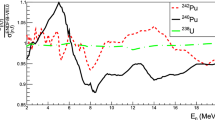Abstract
In the middle of 2018, a heavy-ion accelerator complex that will be built in South Korea plans to provide the first primary beams into the neutron science facility (NSF) for producing fast neutrons. Deuteron with a maximum energy of 53 MeV and protons with a maximum energy of 88 MeV accelerated by superconducting driver linac (SCL1) will be delivered into the target hall at the NSF. A pulsed neutron beam will be provided for neutron time-of-flight (TOF) and neutron-induced reaction cross-section measurements. At the NSF, white and mono-energetic fast neutrons will be produced when either a deuteron or a proton beam bombards a light nuclei target such as C and Li. Preliminary thermal calculations have been performed with a rotating C (graphite) target and its maximum temperature was about 530 °C, much less than its melting point. For neutron TOF measurements, two flight paths of 5 m and 20 m are considered for high-flux and low-energy neutron beams, respectively. Basically, 0° and 30° neutron collimators will be considered to obtain various neutron energies for the neutron TOF measurements. A clearing magnet is used to deflect the proton beam to a beam dump when it crosses a thin target. In addition, the neutron beam dump will be designed to generate a background due to back-scattered neutrons and photons that should be as low as possible in the TOF area. Fission cross-section measurements with a few percent uncertainties are set to be a short-term ultimate goal after building the neutron TOF facility at the NSF. In order to achieve few-percent fission cross-section measurements at the NSF, we plan to employ a time projection chamber (TPC). It can measure charged particle trajectories in the active volume in three dimensions, as well as the energy deposition, and it can significantly improve the accuracies of the fission cross-section measurements.
Similar content being viewed by others
References
D. W. Muir and M. Herman, INDC(NDS)-423 Distr. G+L, IAEA (2001).
P. P. H. Wilson, FZKA 6218, FZK (1999).
M. Majerle and S. Simakov, INR-Nr. 15/10 FUSION Nr. 368, KIT (2010).
M. D. Heffner, P. D. Barnes, and J. L. Klay, UCRL-TR-217600, LLNL (2005).
Author information
Authors and Affiliations
Corresponding author
Rights and permissions
About this article
Cite this article
Kim, J.C., Kim, G.D., Son, J.B. et al. Neutron science facility for neutron time-of-flight and fission cross-section measurements at RAON. Journal of the Korean Physical Society 66, 478–485 (2015). https://doi.org/10.3938/jkps.66.478
Received:
Accepted:
Published:
Issue Date:
DOI: https://doi.org/10.3938/jkps.66.478




